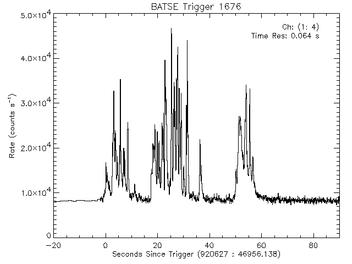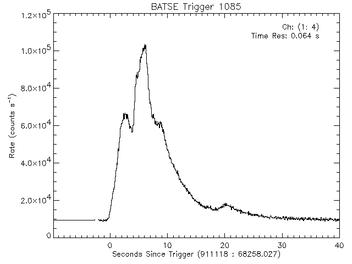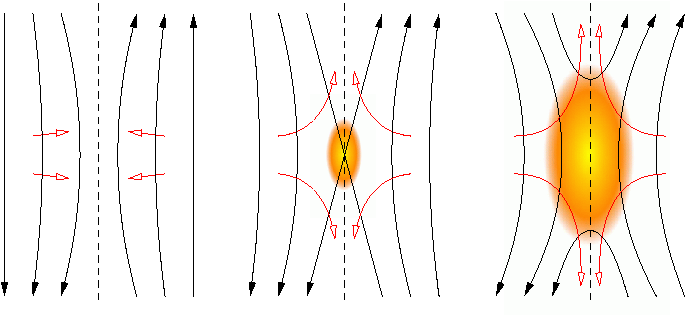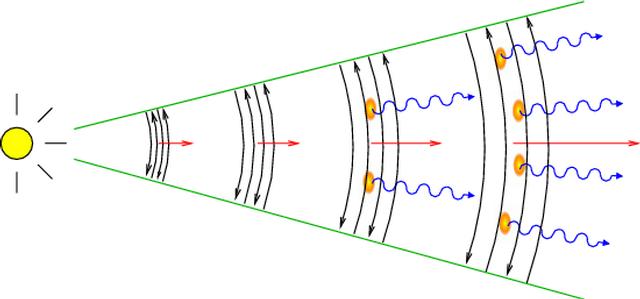Magnetic fields as cause for gamma-ray bursts |
|
Are magnetic fields the key element for the explanation of cosmic gamma-ray bursts? Recent calculations at the Max-Planck-Institut für Astrophysik (MPA) show that strong magnetic fields can be responsible for some observed burst properties. They cause not only the strong acceleration away from the explosion centre but also heat up expelled material in flight. Thus high energy radiation can be emitted which is observed as gamma-ray burst.
Around once a day satellites detect a gamma-ray burst (GRB) somewhere in the sky. For some seconds the detectors receive short wave gamma-rays from a tiny region in the sky which is brighter than all other gamma sources together. The light curves of these bursts are all very different as illustrated in Figure 1.


|
| Figure 1: Light curve example of a gamma-ray burst as detected by BATSE on board of NASA's Compton Gamma Ray Observatory. Plotted are the numbers of photons counted per second with energies of more than 20 keV over the time in seconds. Light curves can be very variable with a chaotic structure (left) but also rather simple (right). No burst is like the other. The light curves of the BATSE detector are all available online. |
In addition to the high energy radiation one observes an afterglow at x-ray, visual, and radio wave lengths. This afterglow lasts for days, weeks or months depending on the wave length.
Since the discovery of the first gamma-ray burst 20 years ago people try to answer what causes the bursts. It was proven in 1997 that the sources of the bursts are very far away. To be visible across half of the universe an object must release an enormous amount of energy.
From the large energy, the rapid variability and the energy spectrum of the radiation follows that one or more compact objects (black holes, neutron stars) must be involved. The gamma radiation itself originates from outflowing material which approaches us with more than 99.995% of the speed of light. Therefore a model for gamma-ray bursts must answer two critical questions:
Both phenomena, the large acceleration and the radiation, can be explained by the help of magnetic fields. Strong magnetic fields are postulated by a couple of theoretical scenarios for gamma-ray bursts. E.g. they can emerge from a fast rotating neutron star or be generated in a coalescence of a neutron star with a black hole. A compact rotating object with magnetic field produces a electromagnetic wave comparable to an antenna.
Plasma which is expelled by the central object causes some interesting effects in the magnetic field. In the outward travelling wave regions of oppositely aligned magnetic fields alternate. By instabilities matter elements in which the field orientation is different can come close to each other. By that the magnetic field decays and the magnetic energy is released and transfered to the plasma. Figure 2 illustrates the principle of the field annihilation.

|
| Figure 2: Simplified 2-dimensional sketch of the magnetic field decay. Differently aligned magnetic fields (black arrows) are brought together by the plasma flux (red arrows). At the meeting point in the middle the fields annihilate and magnetic energy is released locally heating up the matter (yellow-orange indicated). More realistic are 3-dimensional unordered processes. |
Our calculations show that the magnetised outflow is not only strongly accelerated but also heated up. Hot plasma in a magnetic field causes the high energy radiation. Figure 3 illustrates such an outflow. With this model it is possible to answer the decisive questions concerning the plasma acceleration and the radiation.

|
| Figure 3: Schematic picture of the explosion. The central source (yellow) generates oppositely aligned magnetic fields (black arrows). Due to the magnetic field decay the outflow gets accelerated (red arrows) and high energy radiation is emitted (blue curved lines). |
Last modified: Tue Feb 5 10:42:15 MET 2002